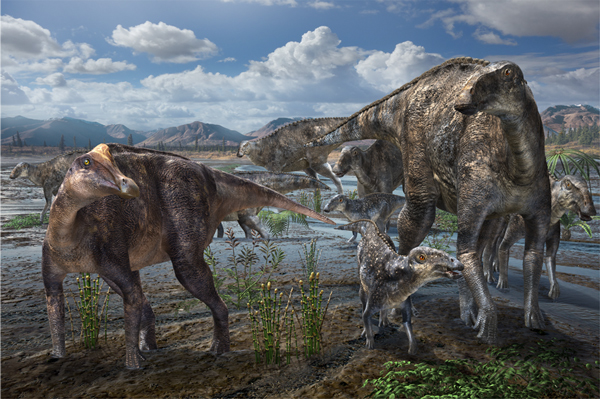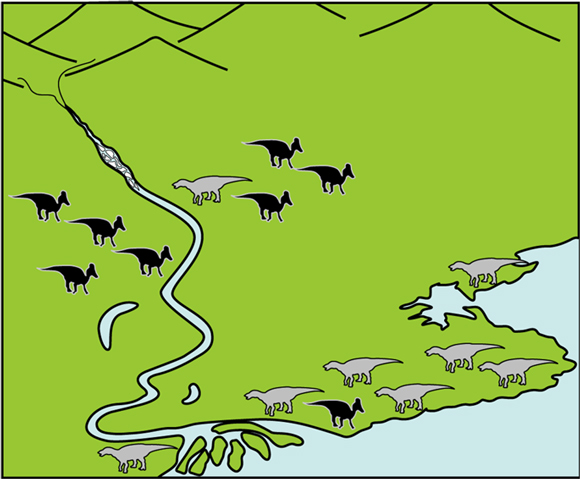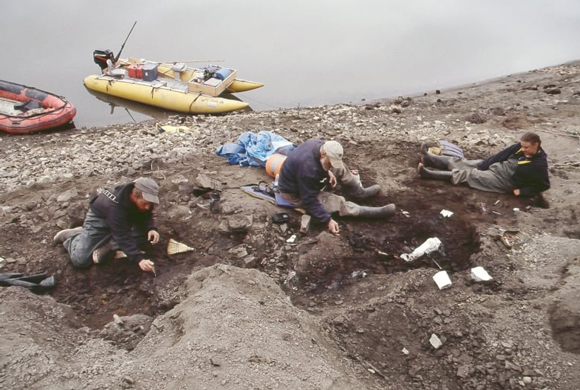The First Alaskan Lambeosaurine Dinosaur Identified
Lambeosaurine Reported from the Liscomb Bonebed (Alaska)
The first fossil evidence of a lambeosaurine duck-billed dinosaur has been reported from the Liscomb Bonebed (Prince Creek Formation) of Alaska. Part of the top of a skull, a bone called the supraoccipital (it forms part of the braincase), has been found during field work on the famous Alaskan fossil site on the banks of the Colville River. This discovery demonstrates that both lambeosaurine and hadrosaurine dinosaurs lived in the high Arctic during the Late Cretaceous. It also suggests that the crested lambeosaurines may have preferred inland environments, whilst their cousins, the hadrosaurines dominated the ecosystem in coastal and low-lying, near shore environments.
Evidence to Indicate that Lambeosaurines Lived in the Arctic During the Late Cretaceous

Picture credit: Masato Hattori
Lambeosaurine Skull Bone
Writing in the on-line, academic journal “Scientific Reports”, researchers from Hokkaido University (Japan) and the Perot Museum of Nature and Science (Dallas, Texas), confirm the discovery of a skull bone associated with a lambeosaurine (crested duck-billed dinosaur) in the hadrosaurine dominated Liscomb Bonebed, a site that has to date, yielded some 6,000 dinosaur bones. The fossils exposed on the banks of the Colville River in a region of Alaska known as the North Slope, represent one of the most important Maastrichtian-aged dinosaur fossil sites in the world. It has provided evidence of a high latitude Late Cretaceous dinosaur dominated ecosystem.
The bonebed is described as a monodominant, multitaxic unit as although 98.5% of all the fossils found represent just one species – the hadrosaurine Edmontosaurus* other types of dinosaur including three theropods have been identified from fossils found at this site too. The supraoccipital confirms the presence of lambeosaurines at this location as well, although, based on the ratio of hadrosaurine to lambeosaurine fossils found, crested duck-billed dinosaurs probably only made up a tiny portion of the entire plant-eating dinosaur community.
Views of the Single Skull Bone (Supraoccipital) Identified as Lambeosaurine

Picture credit: Scientific Reports
The newly described supraoccipital differs from those of hadrosaurines as it has large, prominent bumps towards the back of the bone (squamosal bosses). It is also a different shape when compared to supraoccipital bones associated with members of the Hadrosaurinae such as Edmontosaurus. For example, it is proportionally shorter in length (when measured from the front to the back of the bone – anterior to posterior).
Lambeosaurine and Hadrosaurine
The dinosaur family known as the Hadrosauridae is split into two main, but closely related lineages, the Lambeosaurinae and the Hadrosaurinae. Traditionally, these two groups have been distinguished by their skulls, lambeosaurines having hollow crested skull crests, whilst the hadrosaurines lack bony crests. This assessment might prove too simplistic, but for the time being, the general classification of Hadrosaurs into these two sister lineages remains the consensus.
Classifying the Hadrosauridae (Duck-billed Dinosaurs)

Picture credit: Everything Dinosaur
Co-author of the scientific paper, Dr Anthony Fiorillo (Perot Museum of Nature and Science) stated:
“This first definitive evidence of a crested hadrosaur in the Cretaceous Arctic tells us that we still have much to learn about the biodiversity and the biologically productive environments of the ancient north and that the story these fossils tell us is continually evolving.”
Field Team Members Excavating Part of the Liscomb Bonebed on the Banks of the Colville River (Alaska)
Picture credit: Dr Anthony Fiorillo (Perot Museum of Nature and Science)
A Link Between the Lambeosaurines of North America and Asia
The single fossil bone might not be sufficient to erect a new genus of lambeosaurine dinosaur, but the discovery is extremely significant as it links the dinosaur biota of the most northerly portions of North America to dinosaur faunas from the Late Cretaceous of northern Asia. For example, Nipponosaurus (N. sachalinensis) from the North Pacific island of Sakhalin, is also a lambeosaurine.
Commenting on the connection between Arctic dinosaur faunas and those of the North Pacific, co-author Ryuji Takasaki (Hokkaido University) said:
“This new discovery illustrates the geographic link between lambeosaurines of North America and the Far East. Hopefully, further work in Alaska will reveal how closely the dinosaurs of Asia and North America are connected.”
Known Geographical Distribution of Lambeosaurine Dinosaurs in the Late Cretaceous

Picture credit: Scientific Reports
Lambeosaurines and Hadrosaurines Had Different Habitat Preferences
The Liscomb Bonebed might be dominated by fossil material assigned to the Hadrosaurinae, but the discovery of a single fossil bone indicates the presence of lambeosaurines. This site is representative of a coastal, near-shore environment and it differs from the lambeosaurine dominant structures of localities in Russia and China interpreted as inland environments. The researchers postulate that crested duck-billed dinosaurs (lambeosaurines), preferred inland habitats, whilst the non-crested duck-bills (hadrosaurines), favoured coastal habitats. Different habitat preferences might have been a strategy to avoid excessive competition between these two groups of closely related dinosaurs.
Lambeosaurine and Hadrosaurine Habitats (Inferred from the Liscomb Bonebed)

Picture credit: Scientific Reports
Note: Edmontosaurus*
Things are never that straight forward in vertebrate palaeontology. In 2015, a new taxon of hadrosaurine was erected based on the Liscomb duck-billed dinosaur bones. The new species was named Ugrunaaluk kuukpikensis and although it was believed to be closely related to Edmontosaurus, it was established as a separate taxon. However, in 2017 subsequent analysis challenged this conclusion.
Ugrunaaluk had been erected based on the study of fossil bones from immature individuals of various growth stages. The hadrosaurine bones from the Liscomb Bonebed overwhelmingly represent the remains of juveniles. The establishment of a unique duck-billed dinosaur taxon for northern Alaska remains controversial. Many palaeontologists now consider Ugrunaaluk to be nomen dubium (not a valid genus).
To read Everything Dinosaur’s 2015 article about Ugrunaaluk kuukpikensis: Alaska’s Latest Dinosaur Ugrunaaluk kuukpikensis.
The scientific paper: “The First Definite Lambeosaurine Bone From the Liscomb Bonebed of the Upper Cretaceous Prince Creek Formation, Alaska, United States” by Ryuji Takasaki, Anthony R. Fiorillo, Yoshitsugu Kobayashi, Ronald S. Tykoski and Paul J. McCarthy published in Scientific Reports.
Visit the Everything Dinosaur website: Everything Dinosaur.


